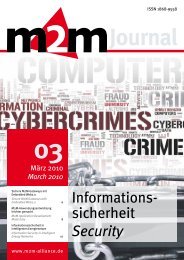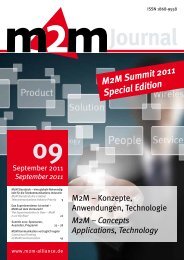Gesundheit Healthcare - M2M Alliance
Gesundheit Healthcare - M2M Alliance
Gesundheit Healthcare - M2M Alliance
Erfolgreiche ePaper selbst erstellen
Machen Sie aus Ihren PDF Publikationen ein blätterbares Flipbook mit unserer einzigartigen Google optimierten e-Paper Software.
Das kleinste im Feld der Mobilfunkmodule ist das größte:<br />
das Telit GE865 hat den geringsten Platzbedarf auf der Platine<br />
und die geringste Leistungsaufnahme.<br />
The smallest in the field of mobile radio modules is the largest:<br />
The Telit GE865 has the smallest footprint on the circuit board<br />
and the lowest power consumption.<br />
auch vermehrt in Datensammlern ein.<br />
Zudem ermöglichen solche Geräte mit<br />
einer Akku-Pufferung auch den mobilen<br />
Einsatz, so dass ein lückenloser Informationsaustausch<br />
auch bei Reisen gewährleistet<br />
ist. Das Telit GE865 benötigt mit nur<br />
22 x 22 mm in BGA-Bauweise den geringsten<br />
Platzbedarf auf einer Platine. Dank<br />
modernster Singlechip GPRS Architektur<br />
im Inneren ist die Leistungsaufnahme optimiert<br />
für mobile Geräte.<br />
In Altersheimen teilen sich oftmals viele<br />
Patienten dieselben Geräte, was eine Benutzeridentifikation<br />
erfordert. Eine manuelle<br />
Identifikation birgt zu viele Fehler, biometrische<br />
Verfahren sind kostspielig und<br />
rechenintensiv. Der elektrische Ausweis<br />
mit RFID ist zuverlässig, günstig und dank<br />
modulare Leseeinheiten einfach in bestehende<br />
Applikationen zu implementieren.<br />
Eine Identifizierung über die integrierte<br />
Unique-ID lässt sich nicht manipulieren.<br />
Die Erfahrung des Wireless Competence<br />
Center der Rutronik Elektronische Bauelemente<br />
GmbH im medizinischen Umfeld<br />
zeigt: Die Geräte sollen ohne Bedieneingriffe<br />
des Patienten auskommen, die Batterielaufzeit<br />
soll mindestens ein halbes<br />
Jahr umfassen und akkugestützte Geräte<br />
eine Woche ohne Netzanschluss funktionieren.<br />
Unterschiede bestehen jedoch in<br />
der Kompatibilitätsstrategie: Einige Hersteller<br />
möchten nicht, dass ihre Produkte<br />
mit Marktbegleitern kommunizieren und<br />
setzen auf hauseigene Protokolle oder verschlüsselte<br />
Standards. Bluetooth Nutzer<br />
werden hingegen künftig auf den neuen<br />
„Bluetooth low energy technology“ Standard<br />
wechseln, der ihre Anforderungen<br />
gezielter abdeckt.<br />
The power supply of the medical equipment<br />
varies depending on the measuring<br />
system and area of application, and the<br />
wireless interface must have an accordingly<br />
low current consumption. In a passive<br />
wireless transmission for example the microcontroller<br />
connects via I²C interface to<br />
Produkte und Entwicklungen Products and Developments<br />
the M24LR64,<br />
a new dual interface<br />
EEPROM<br />
from STMicroelectronics<br />
with<br />
integrated ISO<br />
15693 RFID. The 64<br />
kbit memory chip is connected directly<br />
to a 13.56 MHz antenna; this can be<br />
carried out by the PCB. The 64 memory<br />
blocks can be protected individually<br />
against RFID write or read access.<br />
The microcontroller writes the measurement<br />
data into the EEPROM, from which<br />
they can be accessed by an RFID handheld.<br />
RFID is useful when a small amount of data<br />
is to be transmitted on demand and the<br />
radio link does not exceed a few centimeters.<br />
The new nRF8001 at Nordic Semiconductor<br />
becomes an option if a device has<br />
to bridge distances of a few meters or independently<br />
initiate the data transfer and<br />
still get by with a button cell battery. The<br />
2.4 GHz transceiver chip supports the new<br />
"Bluetooth low energy technology" standard<br />
and only requires a few µA average<br />
current in its connected state.<br />
Mobile base stations combine data<br />
loggers and gateways<br />
Often multiple devices are used to monitor<br />
the health of a patient, such as ECG, blood<br />
glucose monitors or analysis devices. They<br />
send their data to a base station in the<br />
patient's home or directly via GPRS to an<br />
internet server. Since the operating costs<br />
of GPRS are now lower than when using<br />
ISDN, GPRS is used more and more as a<br />
data collector. Moreover, devices with battery<br />
buffering allow mobile use, so that an<br />
exchange of information without interruption<br />
is assured even when travelling. The<br />
Telit GE865 requires only a 22 x 22 mm in<br />
BGA construction, thus being the smallest<br />
footprint on a PCB. The power consump tion<br />
is optimized for mobile devices, thanks to<br />
the latest single-chip GPRS architecture<br />
inside.<br />
In nursing homes, many patients often<br />
share the same equipment, therefore re-<br />
quiring a user ID. Manual identification entails<br />
too many errors; biometric methods<br />
are expensive and computer intensive. The<br />
electronic ID card with RFID is reliable, inexpensive<br />
and thanks to modular reading<br />
units, easy to integrate into existing applications.<br />
Identification via the integrated<br />
unique ID cannot be manipulated.<br />
The experience of the Wireless Competence<br />
Center at Rutronik Electronic Components<br />
GmbH in the medical field shows<br />
the following: devices should be operable<br />
without intervention of the patient; battery<br />
life should last at least six months, and the<br />
power supply of devices using rechargeable<br />
batteries should function for a week<br />
without being connected to the main power<br />
supply. Nevertheless, there are differences<br />
in the compatibility strategy. Some<br />
manufacturers do not want their products<br />
to communicate with market competitors<br />
but rather to rely on their own protocols or<br />
encoded standards. Bluetooth users will<br />
however continue to change over to the<br />
new "Bluetooth low energy technology"<br />
standard, which specifically covers their<br />
needs.<br />
Contact<br />
Bernd Hantsche<br />
Rutronik<br />
Elektronische Bauelemente GmbH<br />
Email: bernd_hantsche@rutronik.com<br />
www.rutronik.com<br />
<strong>M2M</strong> Journal 04 | 06/10 9






